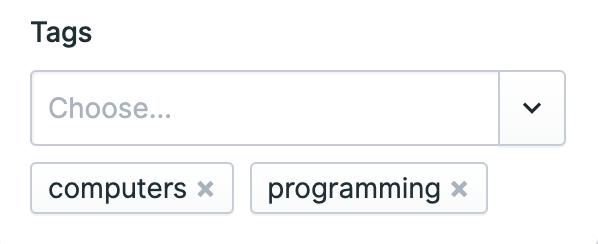Terms Fieldtype
Allows you attach Taxonomy Terms to your content. They could be Tags, Categories, Colors, Flavors, you name it. We highly recommend learning more about Taxonomies before going any further.

Overview#
Taxonomies are usually relationships established on the collection-configuration level. Make sure to read the Taxonomies documentation to understand how everything works.
Data Structure#
If the field is being used for taxonomizing your content (ie. the field name matches the taxonomy handle), the term's slugs will be saved.
wildlife:
- kangaroo
- three-toed-sloth
- panda
- porg
However, if you just want to store references to taxonomy terms for other purposes, the term's IDs will be saved. See below for more detail.
A term ID is the taxonomy handle combined with the slug.
This way, you may reference terms from multiple taxonomies.
things_you_may_find_adorable:
- wildlife/panda
- people/the-elderly
Templating#
As outlined in the Taxonomies Guide, term slugs will automatically be converted to Term objects which means
you will have all of the term's data available as variables.
<ul>
{{ wildlife }}
<li><a href="{{ url }}">{{ title }}</a></li>
{{ /wildlife }}
</ul>
<ul>
@foreach ($wildlife as $term)
<li><a href="{{ $term->url }}">{{ $term->title }}</a></li>
@endforeach
</ul>
<ul>
<li><a href="/wildlife/kangaroo">Kangaroo</a></li>
<li><a href="/wildlife/three-toed-sloth">Three Toed Sloth</a></li>
</ul>
Using terms without taxonomizing#
The most common use for this fieldtype is to taxonomize, or "tag", your entry.
However, sometimes you have other ideas in mind for using taxonomy terms. For instance, you might have a "similar tags" field, or want to create an index of many different, unrelated things. In this case, you aren't tagging the entry itself at all.
When using the taxonomy field in this way, terms will get saved using IDs instead of slugs.
similar_things:
- categories::hats
- tags::delightful
You can still loop through them like your used to:
<ul>
{{ similar_things }}
<li><a href="{{ url }}">{{ title }}</a></li>
{{ /similar_things }}
</ul>
<ul>
<li><a href="/categories/hats">Hats</a></li>
<li><a href="/tags/delightful">Delightful</a></li>
</ul>
Options
max_items
The maximum number of items that may be selected. Setting this to 1 will change the UI to a dropdown.
taxonomy
The handle of the Taxonomy from which to fetch Terms. Not needed when placed in the fieldset's taxonomies array. In that case, it'll get the taxonomy from the field name.
create
By default you may create new terms. Set to false to only allow selecting from existing terms.
query_scopes
Allows you to specify a query scope which should be applied when retrieving selectable assets. You should specify the query scope's handle, which is usually the name of the class in snake case. For example: MyAwesomeScope would be my_awesome_scope.
Docs Feedback
Submit improvements, related content, or suggestions through Github.
Betterify this page

